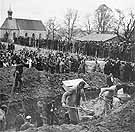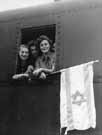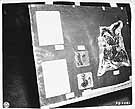
|
|
|

|

|

|

|
|
Click on an image to see a larger, more detailed picture.
|
|
|
|
|
| 1945: Liberation and Rebuilding |

|
pg. 595 |

|
|
|
|
| |
 German civilians dig graves at Buchenwald. Whenever possible, the Allies forced the local population to bury the corpses left to rot in the camps. This both relieved Allied soldiers of performing the grisly task and made the Germans personally confront the crimes committed by their countrymen.
German civilians dig graves at Buchenwald. Whenever possible, the Allies forced the local population to bury the corpses left to rot in the camps. This both relieved Allied soldiers of performing the grisly task and made the Germans personally confront the crimes committed by their countrymen.
Photo: P. Liveright/ United States Holocaust Memorial Museum Photo Archive
|
 These male prisoners freed from Buchenwald all suffered from maladies of the legs and feet. These problems were the product of working under horrific conditions with little to eat, not to mention shoes that did not fit--if the prisoners had shoes at all.
These male prisoners freed from Buchenwald all suffered from maladies of the legs and feet. These problems were the product of working under horrific conditions with little to eat, not to mention shoes that did not fit--if the prisoners had shoes at all.
Photo: AP/Wide World
|
 Young Jews travel to Palestine after being released from Buchenwald. The Americans liberated Buchenwald on April 11, 1945, freeing 21,000 inmates, including 4000 Jews. Most were sent to displaced-persons camps, while others tried to enter Palestine--either legally or illegally.
Young Jews travel to Palestine after being released from Buchenwald. The Americans liberated Buchenwald on April 11, 1945, freeing 21,000 inmates, including 4000 Jews. Most were sent to displaced-persons camps, while others tried to enter Palestine--either legally or illegally.
Photo: Archive Photos
|
 This exhibit of tattooed human skin was presented as evidence of German atrocities during a trial of SS members at Dachau, Germany. The victims had been prisoners at Buchenwald, and their tattoos had attracted the attention of Ilse Koch, the "Bitch of Buchenwald." She allegedly used their tattooed skin to make lampshades.
This exhibit of tattooed human skin was presented as evidence of German atrocities during a trial of SS members at Dachau, Germany. The victims had been prisoners at Buchenwald, and their tattoos had attracted the attention of Ilse Koch, the "Bitch of Buchenwald." She allegedly used their tattooed skin to make lampshades.
Photo: National Archives/United States Holocaust Memorial Museum Photo Archive
|
|

|

|

|
|
|
|
|
| 1945: Liberation and Rebuilding |

|
pg. 595 |

|
|
The Holocaust Chronicle
© 2009 Publications International, Ltd.
|
|
